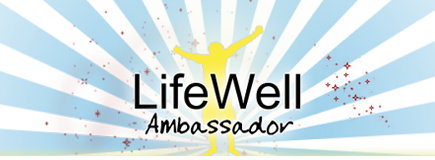About Rich Enion
Rich successfully pitched in the Dragons' Den, then decided to walk away from the deal, up his roots to get on the move with RichEats.TV It's a health blog, most of which is video, that has been growing for more than five years.
From England to Thailand, Australia to the USA, Brazil, Costa Rica, Colombia and beyond, Rich is currently travelling, researching, co-authoring and coaching on motivation, health and fitness. Of course a huge part of your health and wellbeing is happiness, so we've hunted him down and asked him to share some of his personal insights...
Come on then Rich? Let's hear it!
Rich: Let’s not beat around the bush with this. I’m pushing you straight into some of the things I've learnt, been practising and growing into during my five (and more) years of world travel with
RichEats.TV (which actually initially began with a rather self-centered desire to learn everything there was to learn about fat burning – interesting that this journey very quickly shifted to the deeper aspects of health, moving fat burning to a satisfying side-effect).
Everyone is searching for happiness, right? Whether it’s achieving a better work-life balance, earning
passive income (what you earn on a regular basis), securing a higher wage, improving a relationship or whatever your marker is for being happy.
Well, here’s the good news – life doesn't work like that. Outside things don't give internal peace and happiness. You don’t have to wait for
everything in your life to be perfect and in order before you let yourself be happy.
Through my own experience and years of travel, learning about health, fat burning and training, studying and interviewing people from many walks of life, there have been some huge lightbulb moments of understanding and shifts in my feelings about happiness that I've come to feel and experience. (Following this, there is some science for you to geek out on too so hold onto your love handles and let’s get happy!)
So, without further ado...
here are seven (plus a bonus two) Rich Eats ways to a happier face!
1) The counter-intuitive approach
Rather than searching to serve yourself a deeper sense of happiness, look to serve and give to people in some form. It's kind of like the way that fat burning and a sustainably healthy human is actually a side-effect of bigger changes in thinking.
2) Resisting reacting
This is such a great one and something that can be tricky when you’re in the moment, though it really gives you insight and a zoomed-out look at life. Resisting reacting is not to say to suppress your feelings, but rather taking few seconds between something happening and generating your normal reaction to it.
For example: someone does something highly irritating and you get frustrated/annoyed/angry and react emotionally by shouting and causing a scene. That's a pretty instinctive response, right?
Well, what might be possible if you give yourself a couple of seconds before reacting? Try taking a couple of breaths, walk away for a second if you can. Do something to interrupt your normal response.
By doing this you move yourself from being a victim of what is happening to someone who is responsible and able to take action. When you're not the victim you empower yourself.
3) Calm your hormones! (For everyone's sake...)
Let's get physical for a second. Yes – training, movement, exercise or whatever you want to call it, can make you happier (that's a given), but this tip goes a little further.
This one is about adrenal fatigue. Adrenal fatigue is rife in a busy westerner’s life. Stimulants, chemicals, hangovers, stress at work and at home all take their toll. Even the most basic biology lesson on humans and hormones makes it very clear that the sum of stress plus lots of stimulants plus lack of sleep can leave the human with a very unhappy, edgy (not East London edgy) feeling which can lead to some nasty illnesses. I'm not going into the science right now, but know that adrenal fatigue is something to be aware of and that checking out these ways of finding your balance can counteract its effects:
- Yoga
- Deep breathing
- Reducing/cutting or strategically timing your caffeine intake
- Cold showers (swimming in the sea is ideal)
- Putting your hands on hips for two minutes in the superman/woman pose
- Stretching
- Massage
- Feeling the loving touch of another human
These are all valid ways in which you can help balance your adrenal system. And with this goes the saying, “
You can't overtrain, only under-rest” which applies perfectly here.
Make sure to create time to rest your body and mind.
4) Say no
We often say 'yes' just to go along with it, so as not to put someone out or because we think that the consequences will be unbearable.
Saying no when you want to say no (without guilt) is a powerful thing to do for yourself and for the other person, because in that moment you are being true to yourself and standing strong in your integrity. The recipient of your well-grounded 'no' will feel it and respect you for it. In the moment they might be taken aback, perhaps a little peeved, but thinking long term, saying no can bring you a lot of respect, deeper peace and happiness.
Try a 'no day' to practice. It's a simple concept – you say no to everything for the entire day, no matter what it is being offered or asked of you. Just say no.
5) Bored or anxious?
If you're bored then increase the challenges in your life.
If you're anxious and overwhelmed, learn a skill.
Assess where you're at and be present. Simple.
6) Victim or action
When we look at the bare facts of an event, there is
what happened and then there’s
the story we tell ourselves and other people about what happened.
If someone is always in their story then their existence often lies in a whirlwind of assumptions and self-victimisation, which makes it very difficult to achieve peace and happiness.
Something happened, now take action.
7) Fooding and connection
Just like losing your liver, without the trees in our world we have minutes to live.
It's funny how we often hear people say that they are going away for a few days to re-connect when the truth is we are always connected. So what has this got to do with food and happiness?
The food we eat, where it came from, how it was grown, the hormones put into the animal, the health and wellbeing of the animal, the chemical fertilisers and pesticides used on the plants, fruit and vegetables (the list goes on and on...) are all part of the environment, your environment.
Bringing this awareness of infinite connection to the things you put in your mouth changes everything.
For years, eating together with friends and family has been a time to share. To sit down together and connect with your loved ones might sound a little stereotypical, but this kind of connection is fundamental to human health and happiness.
Now for your two bonus tips:
8) Mind what you eat
This is not just about what you eat, but your state of mind whilst eating. Of course there are numerous distinct ways to eat a meal. For now let's look at two of them.
Take person A – they look at their soup and think "Oh no, I've got to eat this damn soup because I'm not healthy and I need to lose weight or I will die". OK, a slight exaggeration, but you get the point. In short, person A is not too happy about their soup.
Person B on the other hand looks at the same soup and thinks very differently. They look at it and appreciate all of the nutrients inside, they know it's organic and that it will nourish their body and mind. They even appreciate the work and craftmanship that went into bringing that dish to them. They deeply appreciate that bowl of soup, even whispering a little thank you to it.
A or B?
9) Call the fire brigade!
This one is about food allergies and inflammation! We talk loads about this in our forthcoming book, but for now know this: the food you eat and the drinks you consume can cause inflammation. Inflammation is like being on fire on the inside and has been linked to causing depression. Of course, a fire in your liver or stomach is going to make you anything other than happy! Like I said we talk all about this in our book and on
RichEats.TV. Simply knowing that begins your adventure into chilling out a little.
So, what should you do now?
Having read all that you might be sitting there wanting something to do with all of this information, a little take-away for you to build upon. Just sit with it for a moment, perhaps look at your foot or arm, and absorb your new-found knowledge. Then, when you’re not trying to do anything, see which of the above applies most to you in your life right now and take action. Motivation is great, but your happiness and change comes in the action you take.
The invitation here is for you to let go of the restriction, leave the victim behind, consciously move forward and be in the life you want to live.
Keep reading on to geek out on some of the deeper science and philosophy of happiness.
There is a great gent called Dr Bruce Lipton. He's a scientist who was on the Newtonian path (‘everything is physical’), but as soon as his research led him to quantum physics, his studies and life took a u-turn.
The learning was about energy – deep in our body we have cells, and inside our cells we have molecules, and inside the molecules are atoms. Got that? Read it again if you want to before moving on to this next part.
Now, check this out, inside the atom there is just energy (this fact is the science behind mobile phones, sound wave vibrations being used to explode kidney beans, I mean kidney stones, and unfortunately, how the atom bomb was made). That's what is in there, pure energy. Dr Bruce wrote that “If you shrink yourself to the size of an atom, and you go inside the atom and take photos, when you develop the photos they will be blank”.
So... Rich... How is this related to happiness?
Rich: Bear with me… we are getting to the point now…
What this means is that if it's just energy inside the atom, and the atom makes up the molecule, and the molecule makes up the cell, then the human body is made of… energy! Everything is energy!
The end is now. Not
the end, just the end of this article, abruptly stopping half way through the energy part, but I think it’s better to send you to
this secret page on my blog if you are up for reading more.
It’s some intensely interesting stuff so
click here to continue...
For loads more about this unusual roving health character you can follow and like Rich Eats on:
FaceBook:
Facebook.com/RichEats
Instagram:
@RichEats
Twitter:
@RichEats
Rich is also a
LifeWell ambassador. LifeWell is devoted to helping people in the UK and beyond to receive effective
wellness guidance. LifeWell works with, promotes and supports high integrity
researchers, teachers and organisations whom embody a deep, authentic
and scientific understanding of holistic wellbeing. LifeWell aims to
make life-transforming guidance available to all, facilitating events
and projects which provide accessible entry points for people in a wide
range of different circumstances. This includes LifeWell hubs at events around the UK, workshops and retreats and, from 2016 onwards, We for Wellness, a community-based project designed to reach out to young families, especially those in challenging situations.






































